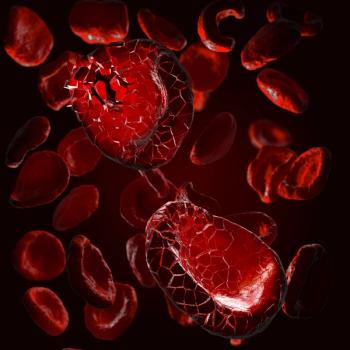
- ONCOLOGY Vol 16 No 3
- Volume 16
- Issue 3
Progression-Free Survival After Six Years (Median) Follow-Up of the First Clinical Trial of Rituximab/CHOP Chemoimmunotherapy
The first clinical trial of rituximab (Rituxan) in combination with CHOP chemotherapy (cyclophosphamide [Cytoxan, Neosar], doxorubicin HCl, vincristine [Oncovin], prednisone) was initiated in April 1994 (J Clin Oncol 17:268, 1999). This study showed the safety and efficacy of the combination in low-grade non-Hodgkin’s lymphoma (NHL) and enabled progression to phase II trials in intermediate-grade NHL (J Clin Oncol 19:389, 2001). In addition, the Groupe d’Etude des Lymphomes de l’Adulte (GELA) randomized phase III study has shown a statistically significant increase in progression-free survival for rituximab/CHOP as compared with CHOP alone (Blood 96:223a [abstract 950]).
The first clinical trial of rituximab (Rituxan) in combination with CHOPchemotherapy (cyclophosphamide [Cytoxan, Neosar], doxorubicin HCl, vincristine[Oncovin], prednisone) was initiated in April 1994 (J Clin Oncol 17:268, 1999).This study showed the safety and efficacy of the combination in low-gradenon-Hodgkin’s lymphoma (NHL) and enabled progression to phase II trials inintermediate-grade NHL (J Clin Oncol 19:389, 2001). In addition, the Groupe d’Etudedes Lymphomes de l’Adulte (GELA) randomized phase III study has shown astatistically significant increase in progression-free survival forrituximab/CHOP as compared with CHOP alone (Blood 96:223a [abstract 950]).
Characteristics of the 40 patients with low-grade/follicular NHL(International Working Formulation A, 9 patients; IWF B, 17; IWF C, 13; IWF D,1) entered on our study are as follows: 21 males, 19 females (31 naive, 9previously treated); median age, 48 years (range: 29-77 years); and 83% stageIII/IV at diagnosis. CHOP was administered at standard doses every 3 weeks forsix cycles, along with six infusions of rituximab (375 mg/m²/dose). Two doses ofrituximab were given both at the beginning and end of therapy, as well as singledoses before the third and fifth cycles of CHOP.
Adverse events were mostly grade 1/2. Of all events, 17% were grade 3/4 andconsisted primarily of hematologic or infectious toxicities felt to beassociated with CHOP chemotherapy. Human antimouse antibody and humanantichimeric antibody responses were not seen. Of 40 patients registered, 38were treated (two received no therapy) and 35 completed all therapy.
All patients treated responded (58% complete responses [CR], 42% partialresponses [PR]), and the overall response rate in patients who completed alltherapy was 100% (63% CR, 37% PR). Median duration of response is 63.6+ months,with median progression-free survival (PFS) not reached after a medianobservation time of 65.1+ months. Twenty-one patients are still in remission at46.8+ and up to 86.3+ months. Seven of eight bcl-2-positive patients convertedto polymerase chain reaction (PCR) negativity in blood and marrow (molecularcomplete remissions). Of these seven patients, six remain in CR and four remainPCR negative by serial analyses.
Naive and previously treated patients had similar demographics. Kaplan-Meiergraphs for PFS are not significantly different, although there is a trend forlonger time to progression for the naive patients (P = .409, log rank). The PRand CR patients had similar demographics. Kaplan-Meier graphs for PFS show asignificantly longer time to progression for the CR patients (P = .017, logrank).
CONCLUSION: Rituximab can be safely combined with CHOP, resulting in a highresponse rate and a prolonged PFS, without causing significant additionaltoxicity. The conversion of bcl-2 from positive to negative by PCR in blood andmarrow indicates clearance of minimal residual disease. The prolonged PFS seenin this study exceeds that reported in CHOP (alone) studies.
Articles in this issue
almost 24 years ago
Single-Agent Rituximab in Early-Stage Chronic Lymphocytic Leukemiaalmost 24 years ago
Recruitment for Trial of Adjuvant Trastuzumab Under Wayalmost 24 years ago
Rituximab in the Treatment of Acquired Factor VIII Inhibitorsalmost 24 years ago
Support for New Medicare Pay Formulaalmost 24 years ago
Irinotecan-Containing Regimen Improves Survival in Small-Cell Lung CancerNewsletter
Stay up to date on recent advances in the multidisciplinary approach to cancer.


















































































